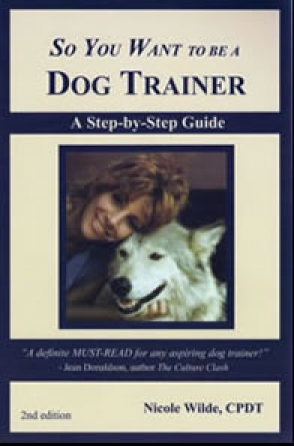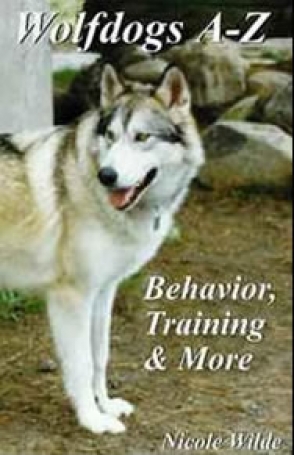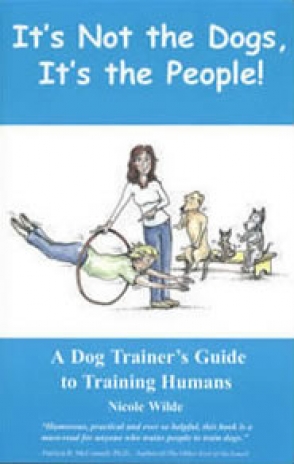Imagine a gentle, non-invasive healing method that can address pain, injury, and illness; speed recovery after surgery; and have remarkable effects on fear, anxiety, aggression, depression, and trauma. Energy healing can do all this and more!
DogTown Versus The Dog Whisperer
There’s a new dog show in town courtesy of National Geographic, the same station that broadcasts The Dog Whisperer. It’s called DogTown, and profiles dogs who have been rescued from situations ranging from sad to downright horrific. The dogs are brought to Best Friends Sanctuary in Utah, where they are rehabbed physically and behaviorally by a team of trainers.
The premiere episode of DogTown focused on 22 pit bulls confiscated in the Michael Vick case. Most had been used for fighting, and a few had been used as bait dogs. Between showings of DogTown, Nat Geo aired a new episode of The Dog Whisperer subtitled Dueling Pit Bulls. The difference between the two shows in their approach to behavior modification was evident.
The majority of the DogTown dogs were unsocialized to people, and some had never even walked on a leash. Many were dog aggressive, of course, and a few showed aggressive behavior toward people. The trainers at DogTown explained that the aggressive-seeming behavior was actually fear-based, stemming from a lack of socialization. They would not physically correct the dogs, but would address the behavior by teaching the dogs to trust people.
The Dog Whisperer case involved two female pit bulls, roughly the same age, who were fighting at home. The couple who owned the dogs had had them together for some time without incident. After running into a man at the park who had well-behaved Rotties, they decided to send the dogs off to his trainer (an unidentified man, not Cesar). Three weeks later, the dogs came back with puncture wounds they’d inflicted on each other. After that, the dogs began fighting at home. The owners successfully managed the situation by keeping the dogs separated, but it was putting a strain on their home life and relationship. Enter Cesar. According to the owners, the pit bull named Sandi was fine with other dogs. Trinity, on the other hand, not only attacked Sandi in the home, but was aggressive toward unfamiliar dogs. It was mentioned that Sandi might have instigated some of the fights by staring or showing other confrontational body language toward Trinity. Cesar deemed Trinity a “red zone dog” (indicating a very high danger risk).
Back at DogTown, the trainers faced a difficult task: working with dogs who had specifically been used for dog fighting and had no socialization with people. Many were fearful, some fear-aggressive. The approach taken was gradual desensitization. For the dogs who weren’t social with people, at first, someone would simply spend time in the pen with the dog, reading or just sitting, not forcing the dog to interact. The dogs were allowed to progress at a pace at which they felt comfortable, and they eventually would come up and sniff at the person, becoming gradually more confident and taking more chances at interaction. As to the dog-aggressive dogs, they were introduced to one other dog at a time, very carefully. The introductions were done by first walking the dogs along on long-lines, then, when the trainers felt it was safe, letting the long-lines drop. The trainers remained calm and gave verbal encouragement any time the dogs acted in a friendly manner toward each other.
At the Dog Whisperer’s compound, with the owners present, Trinity was muzzled and led to a large pen that contained Cesar’s large, established pack of dogs. These ranged from other pit bulls and large breeds to a pit puppy, a Chihuahua, and other small dogs. There was plenty of growling going on from both sides of the fence before the introduction, but when it was felt that the dogs had calmed down, Trinity was let in with the pack. She was visibly nervous, and at one point received a collar correction for what I can only assume was growling at another dog (it was difficult to hear). There were no incidents, and Trinity was left there for training. When the owners came to visit, Trinity was loose and unmuzzled with a number of other dogs (about 10, I believe) outside of the enclosure. None of the dogs wore leashes or collars. A fight broke out between Trinity and another pit bull, and some of the other dogs, also aroused, began fighting. Trinity and the other pit locked on to each other’s jaws. (As it turned out, the two needed five stitches apiece.) A few people (who I believe were associated with the show) jumped in. Trinity’s female owner scooped a small dog off the ground and held it to keep it safe. After a bit of effort, Cesar and another man dislodged the two pit bulls as the horrified owners looked on. (This was accomplished by each man holding a dog and, as Cesar advised, “just waiting” – no breaking sticks involved.) Cesar then immediately put himself, Trinity, and the dog she’d fought with into a small pen together, so the dogs could experience “recovery”—being in each other’s company in a calm manner.
At DogTown, progress was being made. The handsome, shy black pit bull named Cherry was making major bounds in trusting people. The formerly fear-aggressive dog was, while leashed on a long-line for safety, successfully meeting new people. It wasn’t all wagging tails and progress, though; two of the dogs who were introduced while wearing long-lines began to fight. But thanks to the lines, the trainers were able to separate them just as it started, and then calmly moved the dogs away from each other. They decided to let the dogs calm down, and to try another day.
The Dog Whisperer informed the owners that the prognosis for Trinity was not good. He suggested that they “swap” dogs with him, leaving Trinity to live with him for life, and take another dog home in her place. This did not sit well with the owners, especially the woman who had become so attached to Trinity. During a discussion where they all sat in Cesar’s small trailer (which sat on the site-to-be for his new training center), Trinity, the “red zone dog” who had been deemed so aggressive that she was not workable in the home, was present, unmuzzled, along with a large male pit bull named Daddy who belongs to Cesar. The dogs got into a fight. (Trinity was certainly getting plenty of chances to practice.) Directly afterward, when someone tried to lead Daddy out of the trailer, Cesar said no, he wanted them both in there together – more “recovery.”
Back in DogTown, two of the pit bulls who had formerly had issues with other dogs were making continued progress. After a careful introduction on long-lines, after a tense moment or two, they ended up playing. The trainers were thrilled. In fact, many of the formerly unsocialized dogs were making great progress. A staff member explained that some of the dogs would be adoptable into homes, but many would not. They would continue working with the dogs, slowly and carefully. The takeaway message was that these dogs had a very unfortunate history, but that with love, patience, and a careful, gradual, well-managed approach, their behavior could be modified.
Cesar’s message to the owners of Trinity and Sandi was that they were not strong enough leaders. (In the owner’s defense, the woman was not what I would call a pushover by any means, and this same message has been delivered to every owner during every episode I’ve ever seen.) They simply needed calm, assertive energy, he explained, in order for the dogs to continue to get along at home. (The owners’ energy couldn’t have been that bad to begin with, since the dogs had been getting along fine at home before being sent off to the first trainer.) Cesar delivered Trinity back to her home. As he went to remove her from the back of his vehicle, he mentioned that she’d been wearing an e-collar at his place, set to vibrate, and that would be one more tool the couple could use. In the home, when asked by the woman if they could leave the dogs unsupervised in the house if they needed to go into another room (as it would be difficult to supervise them 24/7), Cesar assured them that would be fine. There was a follow-up at the end of the show saying that the dogs were successfully living together.
The differences between these two shows were obvious, both in the approach taken to behavior modification, and in the safety measures taken when working with the dogs. Of course, being television, things are edited and voice-overed, and we don’t know exactly went on in either show. But here are a few observations:
- It was wonderful to hear trainers on both shows state that the problem is not with the pit bull breed, but with the individual dog.
- Unfortunately, on the Dog Whisperer, the public receives misinformation via Cesar’s comments to the owners. For example, he tells them that Trinity’s raising her front paw a bit off the ground when the owners walk in is a sign that she’s becoming aggressive. (He states that she is being protective of the owners. I believe it’s more a case of status by association, where she feels more confident with the owners there as backup, but it is possible.) A raised paw can certainly be a sign of appeasement or anxiety, but aggression? No.
- Dogtown, while not perfect (for example, it’s inadvisable for a person to crouch down when being introduced to a dog who’s shown aggressive behavior toward people), doesn’t display any cautions or disclaimers for viewers; their methods don’t warrant it. The Dog Whisperer has many warnings to viewers not to try these methods at home.
- Putting two dogs who are aroused because they have just fought into an enclosed space together is a very bad idea, and could easily lead to more fighting. Owners, please don’t try this at home!
- Regarding the “putting the dog-aggressive dog into the pack” approach: if you took a teenager who was prone to violence with other kids, and put him in the middle of an established gang, how do you think he’d behave? The survival instinct is strong in both dogs and humans, and just like those dogs, most humans wouldn’t do a thing; they’d try not to get hurt. You can bet that kid wouldn’t pick a fight. So how does the canine pack situation translate to behavior with the other dog at home? What if that teenager you put in with the gang tended to beat up on his little brother at home; do you think, having behaved non-violently in the gang scenario, that he’d go home and act differently toward his brother? I doubt it, and am not convinced, despite the follow-up, that the two dogs in this case are living happily ever after. It would have been helpful to explore the body language and signals that Sandi was giving that started the fights, and for the owners to be taught to recognize those signals and avert fights to begin with. Obviously that alone wouldn’t solve the situation, but it is an important component. Of course that might not have made for scintillating viewing.
- There is a scene in The Dog Whisperer episode where the couple is in the back yard with both of their pit bulls. The dogs get into a fight. The couple, who are standing nearby, immediately take the dogs by the hind legs and try to pull them apart. This takes long, horrific seconds. The woman is clearly panicked, as anyone would be. They get the dogs separated. Now, think about it: it’s being filmed. How do you suppose that setup where the dogs might potentially fight happened? I don’t claim to know for sure, but it would seem that the scene had to be set up and filmed for the purpose of inclusion in the show. Why else did both owners happen to be right there to grab the dogs, and why else wouldn’t whoever was videotaping help the obviously struggling owners to separate the dogs? Of course, the scene is ratings heaven--sensationalism at its best. But is it ethical to set dogs up to fight for our entertainment? How ironic, being that the show was sandwiched between episodes of a show that rehabbed fighting dogs. And of course, it just gave Trinity one more chance to practice fighting.
It’s great that more shows about dog behavior are making it into the public eye. And whether it’s The Dog Whisperer or It’s Me or the Dog, they have certainly encouraged more owners to exercise their dogs and to call trainers for assistance. But with such a wide viewing audience and so much potential to influence the way people understand dog behavior and approach modifying it, I can only hope that DogTown is a sign of things to come.










